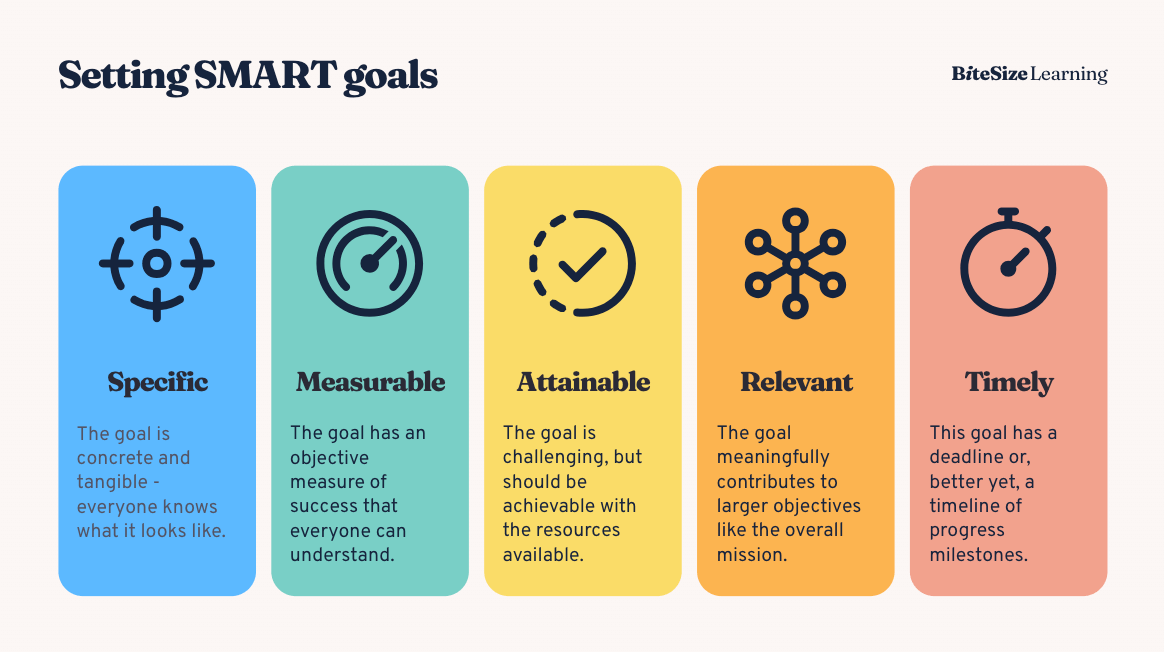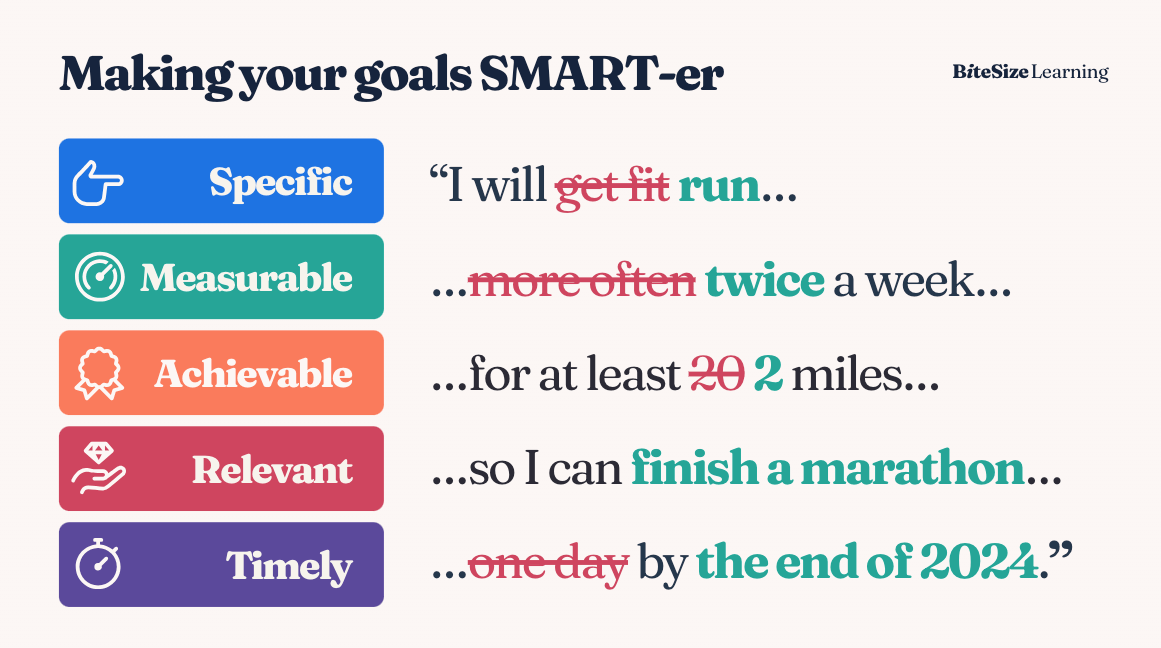SMART goals: a guide to setting goals that matter
Library → Models and frameworks → SMART goals
In every organisation, goal setting is a critical component of success. As a manager, understanding how to set strategic, clear, and actionable goals for your team can make the difference between success and failure.
One of the most effective frameworks for goal setting is the SMART Goal methodology.
What are S.M.A.R.T. goals?
SMART is an acronym that stands for Specific, Measurable, Achievable, Relevant, and Time-bound. The framework is a systematic and simple guide to goal setting that ensures the goals are clear, focused, and practical.
The five key attributes of SMART goals. Grab a high-res version of this graphic,
1. Specific
The first step in setting SMART Goals is to make sure each goal is specific. A specific goal clearly identifies what is expected, why it is important, who's involved, where it is going to happen, and which resources are involved in its achievement. It answers the 'W' questions: What, Why, Who, Where, and Which.
For example, a vague goal might be "Improve customer service." A specific goal, on the other hand, would be "Decrease customer complaint response times."
2. Measurable
Goals should be measurable so that there is tangible evidence that you have accomplished the goal. They should answer questions like: How much? How many? How will I know when it is accomplished?
Continuing the earlier example, "Decreasing customer complaint response times by 20%" is a measurable goal. You can track the response times and quantitatively assess whether or not the goal has been achieved. Some goals are all-or-nothing (‘Switch to the new operating system’) while most will be more variable. For the latter case, you’ll have a better sense of progress and proportion (e.g: that reducing response times by 19% is a close miss, or by 40%, a massive over-performance.)
3. Achievable
Goals should be achievable; they should stretch you slightly so you feel challenged, but defined well enough that you can achieve them. An achievable goal will usually answer the question: How can I accomplish this goal?
If you are trying to achieve a new ‘personal best’ as an organisation, what is the insight, process or practice that will make this new level of performance possible? It's crucial to ensure that the budget, time, and skills are available to implement this system.
In this case we might add: "Decrease customer complaint response times by 20% by implementing a new customer relationship management system."
4. Relevant
The fourth criterion for SMART Goals is that they are relevant. A relevant goal can answer yes to these questions: Does this seem worthwhile? Is this the right time? Does this match our other efforts and needs?
"Decrease customer complaint response times by 20% by implementing a new customer relationship management system, in order to improve our ranking in customer satisfaction surveys."
Connecting your goal to a larger ‘purpose’ makes it more motivating for everybody
By explicitly defining the ultimate purpose of the goal, it creates more clarity in the future:
If emerging information indicates a goal is not making an impact on the ultimate objective, it can be abandoned
If the ultimate objective changes in some way, sub-goals like this one can be re-evaluated to see if they’re still necessary
5. Time-bound
Lastly, goals should be time-bound. This means that they have a start and finish date. When you are working on a deadline, your sense of urgency increases, and achievement will come that much quicker.
In the example goal, we can make it time-bound like so: "Decrease customer complaint response times by 20% over the next quarter by implementing a new customer relationship management system."
SMART goals example
Why setting SMART goals makes a difference
Trying to work as a team without a clear goal is like playing football without, well, a goal.
You might be able to put 11 world-class players on the pitch, but it’s the goal that generates all the activity – otherwise, the match would consist of just 90 minutes of kicking the ball about aimlessly. Final score: ??-??.
Without a concrete target to collectively aim for, individual players might casually pursue their own individual goals – perhaps playing keepie-uppie, seeing who can kick the ball the furthest, or stringing together the maximal number of passes – without the techniques joining together into a meaningful whole.
And without a goal, of course, nobody can ever score: so there are no moments of triumph, accomplishment and collective celebration.
Finally, without an agreed measure of success (or failure) there is no basis to assess the impact of the team or individual players, so it’s impossible to fairly manage performance.
SMART Goals are valuable in management for several reasons:
Clarity and focus: SMART Goals provide clear direction and expectations for team members. This eliminates confusion and aligns the team towards common objectives.
Performance management: Because SMART Goals are measurable, they enable managers to track progress and measure performance objectively.
Motivation: Achievable and time-bound goals can motivate team members as they provide a clear path to success and a sense of accomplishment upon achievement. They also reduce anxiety that work is ‘not good enough’ in an amorphous sense – team members have an objective measure of success, and they can find reassurance in their progress.
Resource Allocation: By ensuring goals are achievable and relevant, SMART Goals help in effective resource allocation.
Common mistakes in setting goals
Using metrics rather than goals: just because you are measuring something (e.g. response time) doesn’t mean it’s become a fully-fledged goal. You need to define what the metric should be!
Not spelling out relevance: the manager might know why the goals are what they are, but does anyone else? It’s critical to tie each goal into a larger story – this also helps the team make delegated decisions to support the ultimate goal of the project.
Letting zombie goals stumble on: no decision-making process is perfect, and sometimes events overtake our initial goals. If some of your goals slide into irrelevancy, you should explicitly disavow them, explain why, and, if necessary, add a new goal in its place. Otherwise, it can infect other goals with the torpid sense that ‘goals here don’t really matter.’ (Zombie Goals can often be spotted when they’re glossed over in weekly meetings with a knowing roll of the eyes or collective chuckle.)
Assigning input or output goals to the wrong people:
If someone is accountable for an output metric, they must have the autonomy to decide how to accomplish it.
If someone is accountable for a task, they should not be held accountable for a follow-on metric they cannot reasonably control.
Some people are do-ers ,which simply means they’re responsible for delivering a certain amount of work at the correct standard. These people should have SMART goals that capture controllable ‘input’ metrics – basically, that they’re getting things done.
Other people are deciders, which means they are accountable for the end results. Their performance relies partly on their judgement, as they need to decide what inputs should happen to achieve these end results.
In our earlier example, a developer or project manager may have the ‘input’ SMART goal of ‘setting up the new client relationship system.’ It wouldn’t be reasonable to assign them the goal of ‘Decrease customer complaint response times by 20%’ because they aren’t accountable for the overall decision-making. (It is, nevertheless, very useful for them to understand faster response times are the ultimate goal!)
On the other hand, the head of customer service should instead be assigned the ‘output’ SMART goal of ‘Decrease customer complaint response times by 20%.’ This makes them accountable for the strategic bet of ‘a new client relationship system will decrease response times.’ If the new CRM doesn’t improve response times at all, the manager has missed their goal even if the project was completed successfully. If decision-makers are only accountable for ‘input’ metrics, they can continue to ‘execute bad decisions effectively’, completing a lot of projects successfully without actually driving any impact.
Wrapping things up
SMART Goals are an invaluable tool for any manager looking to drive their team towards success. By setting goals that are specific, measurable, achievable, relevant, and time-bound, you can provide clear direction, motivate your team, measure performance, and effectively allocate resources.
Remember, the best goals are those that are understood and embraced by the team, so always involve your team members in the goal-setting process.
With SMART Goals, you'll be well-equipped to lead your team to success.





![[Guide] Handling conflict at work: what good managers do differently](https://images.squarespace-cdn.com/content/v1/6348398d9d21fd6277c64f96/1764074828110-OAKDWQ3PJ3E0VQ4BAE84/blog+images+June+2025+%2820%29.png)






![[Guide] Is your team suffering from Artificial Harmony?](https://images.squarespace-cdn.com/content/v1/6348398d9d21fd6277c64f96/1753182447394-5NXQQ9URMXOAOX8ZLZTD/blog+images+June+2025+%286%29.png)